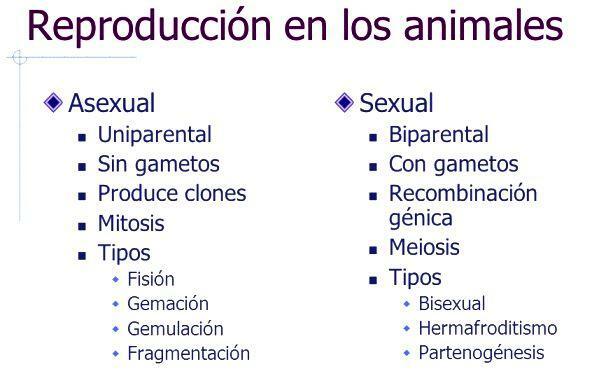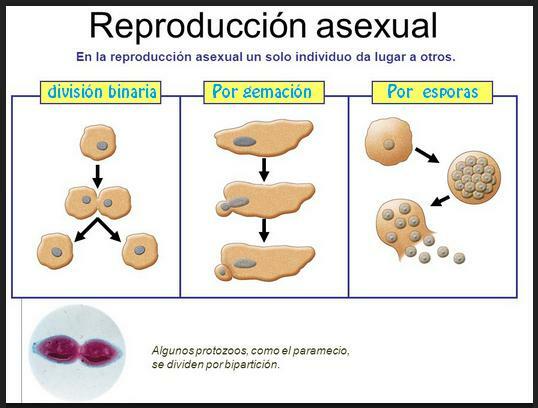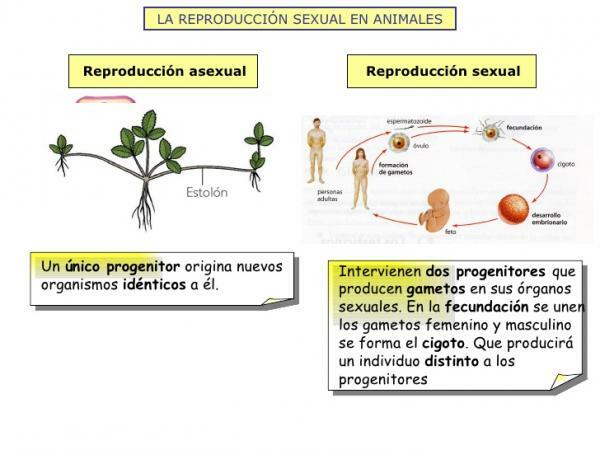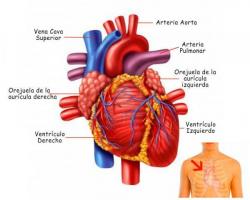Discover ALL types of animal reproduction

Image: SlidePlayer
One of the most important characteristics of living things is their ability to replicate and continue with the species, replacing the organisms that die for one reason or another. This is done through a process called reproduction. Not all organisms do it in the same way, how do different animals in nature reproduce? In this lesson from a TEACHER we will review the types of animal reproduction.
Index
- Asexual reproduction in animals
- Types of asexual reproduction in animals
- Sexual reproduction in animals
- Types of sexual reproduction
Asexual reproduction in animals.
We began this lesson on types of animal reproduction to talk about the asexual reproduction, a type of reproduction in which the parent is divided completely or partially to give one or more individuals with the same genetic information. In asexual reproduction mechanisms there are almost no differences between parents and children since only an individual intervenes and a "photocopy" is made and there are only differences caused by some change environmental or a
genetic mutation.In animals, asexual reproduction only occurs in organisms in which cells can divide and differentiate into the different types of cells that make up the body. This ability is called embryonic totipotency and it is only preserved in embryos or larvae and in very special cells of certain species, mostly invertebrates (sponges, annelid worms, starfish, etc.).

Image: ABC Color
Types of asexual reproduction in animals.
The main types of asexual reproduction in animals are the following:
- The gemmation. During budding reproduction, a bulge called a bud is produced. This bud grows until it forms a complete individual, similar to the starting one, but is usually smaller. This bud can separate from the cell that produced it, forming an isolated individual, or remain attached to it and form a colony. This reproductive mechanism is typical of sponges, jellyfish, etc.
- Fragmentation or excision. Asexual reproduction by fragmentation is one in which the individual is divided into two or more fragments, each of which is capable after reconstructing a complete organism. Reconstruction can occur after the part of the animal has separated (as in starfish) or before it is separated (typical of marine worms called polychaetes). Asexual reproduction by fragmentation is typical of starfish, polychaetes, etc.
- Polyembryony. Polyembryony is an asexual reproduction mechanism that occurs when a zygote gives rise to more than one embryo. That is, a cell resulting from the fusion of a female gamete and a male gamete undergoes fragmentation at a very early stage of its development, before becoming an embryo. These two fragments rebuild and give rise to two embryos. This occurs naturally in some insects, in armadillos (in which all the brothers of the same litter are univitelline twins) and in the case of humans, in univitelline twins (also called true Twins).
- Parthenogenesis. Parthenogenesis is an asexual reproduction mechanism that involves the development of unfertilized female sex cells. The unfertilized ovum, that is, without the male gamete joining it at any time, begins to grow and differentiate to give rise to a complete individual. Normally, this differentiation begins because there are changes in the environment, but in others it is necessary that there is contact with the male sex cell, but in no case does it contribute DNA to the new or new individuals. This special case of parthenogenesis is called geitonogamy. Parthenogenesis is typical of animals such as flatworms, crustaceans, amphibians and reptiles, but the best known case is that of bees, which produce drones through parthenogenesis. Keep in mind that the same animal can have a habitual sexual reproduction (which we will see later) in situations normal and parthenogenesis in exceptional situations (great abundance of food, certain temperature, etc.)

Image: Biology Question Bank
Sexual reproduction in animals.
Another type of animal reproduction is sexual reproduction in which they are involved two organisms of the same species, each of a different sex. Each of these organisms generates a cell called a gamete, which has half of the genetic information necessary to create a living being. The female organism generates gamete called ovule and the male or male organism generates the sperm. As we saw in previous unPROFESOR.com lessons, gametes are generated by meiosis, unlike the rest of cells, which does it by mitosis.
When the egg and sperm unite through a process called fertilization, come together like the two pieces of a puzzle to generate a cell that can give a complete organism. This cell is called a zygote and it will grow, divide and differentiate through different processes (embryogenesis) and will go through different stages until it becomes a completely independent organism from parents.
This process will be familiar to you since it is the one of the humans, that we reproduce through sexual reproduction to have babies.

Image: Slideshare
Types of sexual reproduction.
In turn, the sexual reproduction of all animals is not the same, it will depend on the place where fertilization occurs and where embryogenesis (development of the embryo) occurs. The main types of sexual reproduction in animals They are:
- Sexual reproduction by external fertilization: Fertilization takes place outside the body of the parents, normally in water since it preserves the gametes better. This type of fertilization occurs a lot in fish, in which the female normally releases a large quantity of eggs into the sea; These eggs fall to the seabed and the male swims above them and sprays them with sperm to fertilize them.
- Sexual reproduction by internal fertilization: Fertilization occurs within the body of one of the parents, usually that of the female. This type of fertilization is typical, for example, of mammals.
It depends on where the development of the embryo occurs, we can distinguish three types of animals: oviparous, viviparous and ovoviviparous.
The type of fertilization and embryonic development can be associated in different ways, giving rise to animals with fertilization. oviparous, such as fish and most amphibians, internally fertilized ovoviviparous animals such as sharks or rays, viviparous internally fertilized animals such as chickens or turtles, viviparous internal fertilization such as those of humans, etc.
Do you have any more questions about animal reproduction? Do you want to give us your opinion or contribute something else? Feel free to write in the comments section, we look forward to your input!
If you want to read more articles similar to Types of animal reproduction, we recommend that you enter our category of biology.



